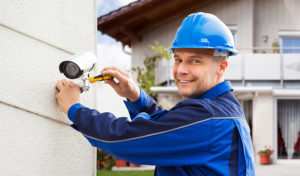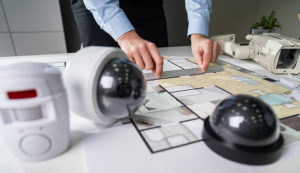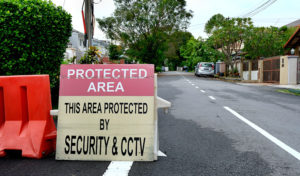Security cameras are a common way homeowners associations keep communities safe. But, there are some considerations when it comes to installing and using them. Before you go all out on an HOA camera system, read through the article below.
HOA Camera for Security: Can Associations Install Them?
Whether or not a homeowners association can install security cameras depends on its governing documents. These documents will typically lay down any rules and regulations concerning the installation and use of cameras.
Beyond the governing documents, there may also be state and local laws regulating the use of security cameras in HOA communities. Generally speaking, cameras can’t be pointed at any space where people have a reasonable expectation of privacy. That means you can’t install them in bathrooms and changing rooms. You can’t even place them in a spot where they capture indoor or privately-owned spaces.
More often than not, you will find HOA security cameras in common areas such as clubhouses, elevators, and reception areas. One of the chief reasons many associations use security cameras is to promote safety in the community. In fact, studies show that such cameras are effective in reducing crime in public spaces.
Can an HOA Restrict Security Cameras?
 It is pretty easy to determine whether or not an HOA can install security cameras in common areas. But, what about homeowners? Can an owner in a homeowners association install security cameras?
It is pretty easy to determine whether or not an HOA can install security cameras in common areas. But, what about homeowners? Can an owner in a homeowners association install security cameras?
While there may be exceptions, most associations won’t allow homeowners to install security cameras in common areas. This is because allowing them to do so would be a security and privacy risk.
However, when it comes to installing cameras inside their own homes, owners generally have the ability to do so. Still, the general rule on privacy applies.
Whether they are located inside or outside the home, cameras can’t be pointed at a place where people have a reasonable expectation of privacy. As such, an owner may install a security camera on their front porch, but that camera can’t face a neighbor’s window or backyard.
Additionally, most security cameras installed outside the home are considered architectural changes. Therefore, owners will usually need to adhere to the association’s architectural standards and application process. This normally means seeking approval from the board or architectural control committee prior to installation.
Considerations for Developing an HOA Security Camera Policy
If your HOA does allow security cameras, it is best to come up with a policy regulating them. This way, you can approve or deny requests for installations based on a standard set of rules. Here are the things you should take into account when creating your HOA camera policy.
Aesthetics
 Architectural guidelines exist to keep the aesthetics of the community consistent. As such, the same should apply to your security camera policy.
Architectural guidelines exist to keep the aesthetics of the community consistent. As such, the same should apply to your security camera policy.
Homeowners requesting to install cameras on the exterior of their property should submit sample pictures of the camera they wish to place. Cameras should coincide with the overall aesthetic of the community.
For security cameras in common areas, HOAs should also go for ones that match the appearance of the space. You should also consider the elements. There are plenty of cameras designed for outdoor use that can withstand harsh weather conditions.
Location
Privacy is a big deal when it comes to security cameras. As such, your policy should uphold the right to a reasonable expectation of privacy. To do this, consider regulating the location and placement of the cameras. No private or HOA camera should point at spaces where residents expect privacy, such as bathrooms, changing rooms, and the windows of a neighbor’s home.
Supervising and Storing Video Footage
Security cameras record videos and store them for a given time period. Sometimes, the HOA will assign someone to monitor the feed in real-time. However, that would entail an added cost for the association. If no one will monitor the feed all the time, the association should make that clear by posting a sign next to the cameras. This will shield the HOA from possible liability.
Your HOA video surveillance policy should also address access. Don’t allow just anyone to review the recorded footage. Only certain people, such as board members and the HOA manager, should have access to the videos. Homeowners can request a copy, but they will need to issue a subpoena. Make sure to communicate this part of the policy clearly to all members.
Finally, your policy should also talk about how long you have to store recorded footage. If you don’t have an infinite amount of storage, which is usually the case, you will need to delete old videos to make space for new ones.
Notifying Homeowners of HOA Camera and the Policy
All homeowners should know about the existence of cameras in common areas. In addition to some state or local laws requiring them, posting signs notifying people of the cameras can help deter crime.
Furthermore, just like any other policy, the board should distribute the association’s security camera policy to all members. This way, members know what they can and can’t do. Make sure to have an attorney review the policy first, though, before enacting and disseminating it.
Cost Considerations of Security Cameras for HOA Communities
 While cameras can help increase security in the neighborhood, they don’t come free. Security cameras can be expensive depending on what kind and features you want to get. As such, if you want to install security cameras in your HOA, make sure you have money in your budget.
While cameras can help increase security in the neighborhood, they don’t come free. Security cameras can be expensive depending on what kind and features you want to get. As such, if you want to install security cameras in your HOA, make sure you have money in your budget.
Remember that the cost of cameras doesn’t stop at installation. Security camera maintenance is an ongoing expense. If you can’t afford to install a lot of them all at once, start with only one or two and work your way up.
Of course, there is an argument to be made for dummy cameras. Fake cameras can work just as well at deterring crime in a community. But, these cameras don’t actually record anything, so they can pose certain liabilities.
Residents might mistake the cameras as real and rely on them when a crime does occur. An easy fix, though, is to make sure all residents know that they are just dummy cameras. Additionally, even if the cameras are fake, they should still abide by privacy laws.
Between real cameras and dummy ones, though, there is no denying that the former trumps the latter. Just remember to craft a good security camera policy and allocate funds in the budget.
A Helpful Guide
When it comes to HOA camera installation and usage, many associations don’t know how to proceed. As with most things, the first step is to check state laws and your governing documents. From there, you can develop a policy (if you don’t already have one), factor in the associated expenses, and notify all residents.
Managing an entire community can come as a challenge to many boards. This is where Elite Management Services comes in. Call us today at (855) 238-8488 or email us at help@emspm.com to learn more about our services.
RELATED ARTICLES:
- HOA Traffic Enforcement: How To Prevent Reckless Driving In The Community
- Is It Legal To Fly Drones In HOA Communities?
- HOA Records Security: Ensuring Your Data Is Safe And Secure







